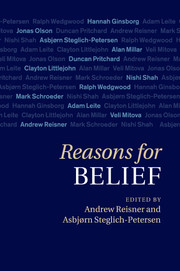Book contents
- Frontmatter
- Contents
- Contributors
- Preface
- Introduction
- PART I NORMATIVE REASONS FOR BELIEF
- PART II REASONS AND EPISTEMIC JUSTIFICATION
- 6 Reasons and belief's justification
- 7 Perception, generality, and reasons
- 8 Immediate warrant, epistemic responsibility, and Moorean dogmatism
- 9 Primitively rational belief-forming processes
- 10 What does it take to “have” a reason?
- 11 Knowledge and reasons for belief
- 12 What is the swamping problem?
- References
- Index
7 - Perception, generality, and reasons
Published online by Cambridge University Press: 05 July 2011
- Frontmatter
- Contents
- Contributors
- Preface
- Introduction
- PART I NORMATIVE REASONS FOR BELIEF
- PART II REASONS AND EPISTEMIC JUSTIFICATION
- 6 Reasons and belief's justification
- 7 Perception, generality, and reasons
- 8 Immediate warrant, epistemic responsibility, and Moorean dogmatism
- 9 Primitively rational belief-forming processes
- 10 What does it take to “have” a reason?
- 11 Knowledge and reasons for belief
- 12 What is the swamping problem?
- References
- Index
Summary
In the last two decades there has been much debate about whether the representational content of perceptual experience is conceptual or non-conceptual. Recently, however, some philosophers have challenged the terms of this debate, arguing that one of its most basic assumptions is mistaken. Experience, they claim, does not have representational content at all. As they see it, having a perceptual experience is not to be understood on the model of thought or belief, as a matter of the subject's taking things in the world to be this or that way, or of having this or that feature. Nor is it to be understood on the model of receiving testimony about how things are in the world, as a matter of its being represented to us that things are this or that way. Rather, it is simply a matter of our being presented with things. To have a perceptual experience of an object is to stand in a certain kind of relation to it which makes it available to us to be represented in thought or belief, but which does not itself involve our representing it, or its being represented to us.
Much of the motivation for rejecting the view that experience has representational content springs from a concern to do justice to what is distinctive about perceptual experience in contrast to thought and belief.
Keywords
- Type
- Chapter
- Information
- Reasons for Belief , pp. 131 - 157Publisher: Cambridge University PressPrint publication year: 2011
- 13
- Cited by



